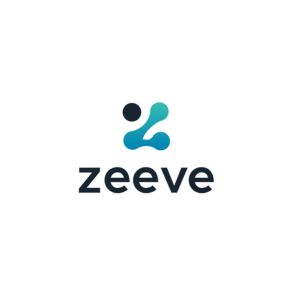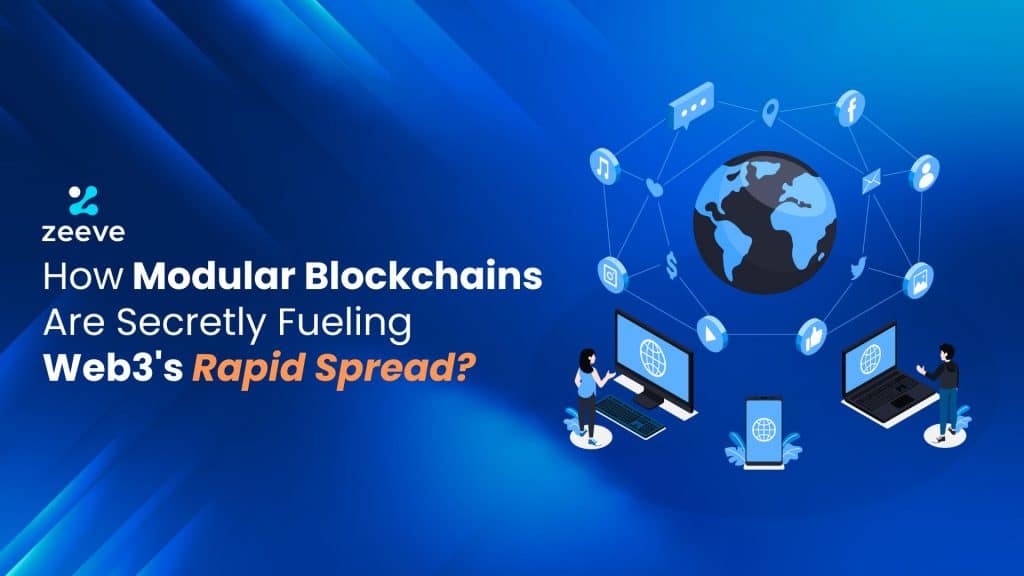How Modular Blockchains Are Secretly Fueling Web3’s Rapid Spread?
 Zeeve
Zeeve
In early 2008 blockchains were introduced as POCs. As time passed, new technological upgrades in the form of smart-contract powered blockchains happened that supported a wide range of applications satisfying different sectors. However, one notable thing to acknowledge during this period was the rigidity of the blockchain infrastructure.
For example, since everything from execution to consensus, to settlement to data availability occurred on the same layer, it was difficult for applications to quickly deploy and get started as per their own terms and conditions. At the same time, the monolithic nature of the blockchain didn’t allow applications to have full control and develop as per their specific requirement based need.
With such a record, onboarding 10% of the GDP on blockchains as claimed by WEF was difficult until and unless applications that are getting developed on top of a blockchain have control over deciding their TPS, governance, tokens and interoperability. That’s where modular blockchains have provided a way forward to fuel the spread of Web 3.
What is Modular Blockchain?
A modular blockchain is an advanced way to Web 3 development. In a modular stack, you can abstract the settlement, execution and consensus layer as separate and make necessary updates to the same as and when required to satisfy the need of your application. In this way, Web 3 developers are getting more flexibility to build their applications on top of the blockchain as per their own needs without compromising the ethos of blockchain , which is transparency, security and decentralization.

How Modular Blockchains Provide Flexibility To Developers?
Modular blockchains abstracts every segment as independent of the other and make the ecosystem functional as a whole.
They are achieving the same by abstracting the following segment;
Base Layer:
Unlike a monolithic blockchain, a modular blockchain allows the developer to abstract the whole blockchain stack and make necessary adjustments that suit their needs. For example, imagine you are launching a gaming application where you need supposedly 10,000 TPS per second. Ideally, such a high throughput is not possible when execution, settlement and consensus happen on the same layer. So, the modular blockchain will allow the application to use the base layer or L1 only as the consensus and settlement layer and move other functionality to other layers. For example, as given in the image above, the blockchain can use sequencers like Espresso and Astria to receive the transactions and arrange them for execution on any rollup network like Optimism, Arbitrum or Polygon.
Execution Layers:
Modular blockchains allow applications to choose a separate execution environment other than L1. So, applications can choose L2s as their execution environment. However, L2s can be chosen for a general purpose scaling only; hence, if an application wants to scale to somewhere around n times the transactions, where n denotes their specific requirements, it is not possible on an L2 with a block space divided among different applications sharing the L2 execution environment. For that matter, the application needs another dedicated execution environment that L3s provide, while using L2 as their settlement layer. In this way, the developers get the discretion of adjusting the execution environment as per their specific need without having to adhere to specific standards of the blockchain with respect to block space and technology stack or language complexities.
Data Layer:
Finally, we have an independent data layer that will store all the details of the transactions that are happening on L2s or L3s and provide a succinct proof of that transaction to be posted on the mainchain for settlement. In this way, they ensure the integrity of the transaction without putting unnecessary load on the network because all the data can be stored off-chain to a different layer like Celestia, Near, Avail or EigenDA and streamline data integrity and accessibility through their usage in a modular blockchain model.

How A Modular Design Aids in Developing Custom Dapps in Web 3 Space?
Flexibility:
A modular design aids in attaining a very high degree of flexibility. For example, the Arbitrum Stack is a modular blockchain which has attracted more than 75 games in 2023 and another 14 games in 2024. The reason developers are choosing Arbitrum Stack is because of the access to the diversifying network it grants through its Anytrust chains. Since they use DAC, it makes data availability very simple to interact with different blockchains and indulge in value transfer.
These trade-offs have attracted projects to use Arbitrum stack as their go-to choice because they can adjust anything from UX, speed, governance to tokens and function as a comprehensive system on top of blockchain. Aurory, a game developed on top of blockchain, adopted the Arbitrum Stack because other than improving the transaction cost and scalability, they also wanted better interoperability with non-evm chains. Arbitrum’s anytrust chain allowed them to access Solana, which was a non-evm chain to interact with.
This is just one end of the spectrum that we see when we look at modular chains like rollups. Apart from scalability, the thing that deterred businesses to adopt blockchains was rigidity. Now, with a modular stack, the narrative is like build whatever you wish to and not let blockchains shortcomings pull you down. You can have a look at this video to understand how modular blockchains are roasting their monolithic counterparts but both these stacks are relevant, nonetheless for their own reasons.
Scalability:
Whether you are running a gaming dapp or an exchange, you need limitless TPS or Transaction Per Second. However, in order to do that, you need ways to abstract the data storage. In a monolithic blockchain, it is impossible. A modular design allows developers to use a different environment to store data on a different chain, which are less important for the users like transaction details, smart contracts data, and other off-chain data. These data can be stored in an OLTP database because they do not form an integral part of the transaction.
Digital signatures and others can be stored on-chain on the main layer for validation. A modular stack allows this to occur. Fauna is a good example to quote here. It allows developers to give permissioned access to a specific type of data. In this way, the user can dynamically determine the privileges of that data and make room for valuable transactions to be included within the block space of the main L1 for settlement and consensus, while abstracting less relevant functions on an alt-data layer with lower fees to call data from there.
These micro-management of the chains powered by modular blockchains have caused a flurry of rollups to be developed in a short span of time as shown in the image below where you not only see a spike in the universal rollups but even app specific roll-ups because now it is possible to optimize scalability as per the need;
Interoperability:
Interoperability is another key problem that modular stacks like Cosmos SDK have solved from the ground up. The IBC or Inter Blockchain Communication allows different blockchains to interact among each other and transfer value without the need for a central exchange or intermediary. In this way, the developers are relieved from the task of thinking about bridging the blockchains, on the contrary, they can completely focus on improving the features and the dynamics of their Dapps.
Security:
When you are going for a modular blockchains, it decouples different components like execution, settlement and consensus layer. So, as a developer, you are better placed in reducing the risk to a multi-point vulnerability from a single point vulnerability.
Top Modular Stacks To Watch Out For Developing Your Applications
Polygon CDK
Polygon CDK, as a cutting edge open source framework has been designed and developed in such a way that it facilitates quicker deployment of your L2 chain or transitioning your L1 chain to L2 chain. The trade-off of developing your modular blockchain using the Polygon CDK is interconnectedness for faster finality, limitless scalability and access to unified liquidity. Developers prefer Polygon CDK because it offers: (i) High modularity (ii) Hyper Scalability (iii) Unified Liquidity (iv) independent Data Availability (v) Composable Interoperability (vi) Instant Finality
Arbitrum Orbit
Arbitrum Orbit decouples the need for the developers to adjust as per the Ethereum compatibility standards expediting the development process without diluting control in the hands of the developers. So, instead of adjusting everything as per Ethereum which requires almost building from the scratch, the developers can instantly develop and launch their application as per their specific project requirement. Through the use of the Arbitrum Orbit stack, the developers enjoy (i) Gas price reliability (ii) custom protocol logic (iii) Multiple decentralization options using Arbitrum Anytrust chains or settling on Ethereum (iv) UX optimization (v) EVM compatibility
Optimism Op Stack
Op Stack is a modular framework for creating shared standard , open-source, and high quality blockchains . The feature of shared frameworks eliminates the need for building the same software repeatedly, instead, it facilitates the use of Bedrock, which has the necessary tooling in place to quickly launch optimistic rollup chains in just a few clicks. Developers are preferring Op Stack to launch their modular blockchains because it allows: (i) Seamless customizability (ii) Easy Deployment (iii) Hyper Scalability (iv) Resource efficiency (v) Cost effectiveness
Build Your Modular Blockchain with Zeeve
Zeeve is your go-to solution for launching modular rollup chains effortlessly. With a simple click, you can deploy on DevNet, experiment with configurations, and seamlessly transition to testnet and finally mainnet if everything checks out. Customize your setup with options for on/off-chain data availability, centralized/decentralized sequencers, and more.
Our platform supports leading tech stacks like Optimism's OP Stack, Arbitrum Orbit, Polygon CDK, and zkSync ZK Stack. Plus, with 24/7 monitoring, analytics, and alerts, we ensure a smooth and efficient launch for your modular blockchains.
Visit our website or schedule a call with our service team to launch your Web 3 game effortlessly.
Subscribe to my newsletter
Read articles from Zeeve directly inside your inbox. Subscribe to the newsletter, and don't miss out.
Written by

Zeeve
Zeeve
Zeeve is an enterprise-grade low-code Blockchain Infrastructure-as-a-Service platform, compliant with ISO 27001, SOC2 Type II, and GDPR standards. We are the leading provider of Rollups-as-a-Service, dedicated node infrastructure, and hosted subgraphs. All the infrastructure managed by Zeeve includes 24x7 monitoring, Enterprise SLA, 99.9% uptime guarantee, and management dashboards to ensure a secure and scalable infrastructure. With support for all major Blockchains, 27,000+ platform users, and 40+ enterprise clients, Zeeve stands tall as the global go-to provider for Web3 infrastructure.